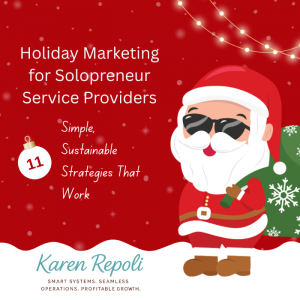As a systems consultant, I see the same challenge over and over: entrepreneurs and small business owners want to grow, engage, and scale — but they’re overwhelmed by all the marketing tools out there. Choosing the wrong tool drains time, money, and energy. Choosing wisely sets your entire marketing engine on the right track.
Here’s a systems-first framework for deciding which marketing tools your business actually needs — now and as you grow.
1. Audit Your Current Toolset and Capabilities
Before you add anything new, take inventory.
What are you already using?
List your tools — CRM, email, e-commerce, social scheduler, analytics, chatbots, forms, project management. Document what each one does and where overlap exists.
Are you using the features fully?
You may already have everything you need but haven’t unlocked the automations, integrations, or advanced workflows available.
Where are your gaps?
Identify which marketing tasks or workflows don’t have a reliable tool — such as lead scoring, referral tracking, or personalization.
This step helps you avoid duplicating tools and may uncover hidden potential in what you already have.
2. Clarify Your Business Goals
Your marketing tools are only as useful as the goals they serve.
What are your immediate priorities?
For example, increasing newsletter sign-ups, improving conversions, or building brand awareness.
What are your long-term growth goals?
The tools you pick today should still support you as you scale, allowing for more automation, higher volume, and deeper personalization.
What metrics define success?
Think in terms of cost per lead, conversion rate, return on ad spend, or customer lifetime value.
A tool that works well today should have the flexibility to evolve with your future systems.
3. Measure What Has Worked — and What Hasn’t
Your past results offer the best insight into your next move.
Which tools delivered ROI?
Look at what has actually produced results — even small ones. Compare tools and platforms you’ve used before and analyze performance.
What didn’t perform?
Sometimes the tool isn’t the problem — it’s the process or data. Before you switch, consider whether optimizing your current setup could deliver better results.
What is your cost of switching?
Factor in migration time, retraining, or workflow rewrites before deciding to move to something new.
If something works, build on it. If not, identify why before adding more complexity.
4. Understand Your Budget — Money and Time
Evaluate tools beyond their monthly subscription cost.
Monetary costs: subscription fees, add-ons, and usage-based pricing.
Time and learning curve: setup, integrations, and training.
Maintenance and scalability: will costs or workloads grow as your business does?
Hidden costs: support, consulting, or development help.
Weigh these against the potential return — both in revenue and time saved.
5. Watch Your Competition and Adjacent Industries
You don’t want to copy what others do, but you can learn from their successes.
What tools are peers using?
Study their marketing funnels, newsletters, and automation styles.
What are related industries doing?
Look at complementary businesses with similar customers and see what’s working for them.
Subscribe and observe.
Join their lists, engage with their content, and pay attention to patterns. Use what you learn as inspiration, filtered through your own goals and systems.
6. Consider Personal Fit and Usability
The best tool is one you and your team will actually use.
Do you like the interface?
A clean, intuitive design reduces friction and boosts consistency.
Does it support your working style?
Whether you prefer drag-and-drop builders or automation dashboards, choose what fits your natural workflow.
Is the support solid?
Strong documentation, active communities, and responsive customer service are invaluable — especially as you scale.
When your tools feel aligned with how you work, they become part of your flow rather than an obstacle.
The Systems Consultant’s Checklist
| Step | Key Questions |
|---|---|
| Inventory | What tools are you using? What features are untapped? |
| Goals | What are you trying to achieve now? What will you need later? |
| Track Record | Which tools delivered ROI? Which didn’t? Can they be optimized? |
| Budget & Capacity | What’s your total investment (money + time)? |
| Market Insight | What are peers and related industries using successfully? |
| Usability Fit | Will you and your team enjoy working with this tool? |
When you’ve clarified your answers, look for tools that integrate seamlessly, scale easily, and automate key processes. Then test your top choices in small pilots, measure the impact, and commit to what truly supports your goals.
Final Thought
Selecting marketing tools isn’t about chasing the latest trend — it’s about designing a system that works for you. The right tools integrate, automate, and simplify. When your technology is aligned with your business goals and daily operations, you move from chaos to clarity.
That’s where systems become your secret to sustainable growth — and your marketing becomes a flow, not a hustle.
If you’re ready to go beyond tools and start building systems that bring calm, clarity, and consistency to every part of your business, my book is the perfect next step.
👉 Get your copy of 11 Systems for the Overwhelmed Entrepreneur: How to Stress Less, Profit More & Build a Business You Love — and learn how to create a business that runs smoothly, supports your goals, and gives you more time for what truly matters.



